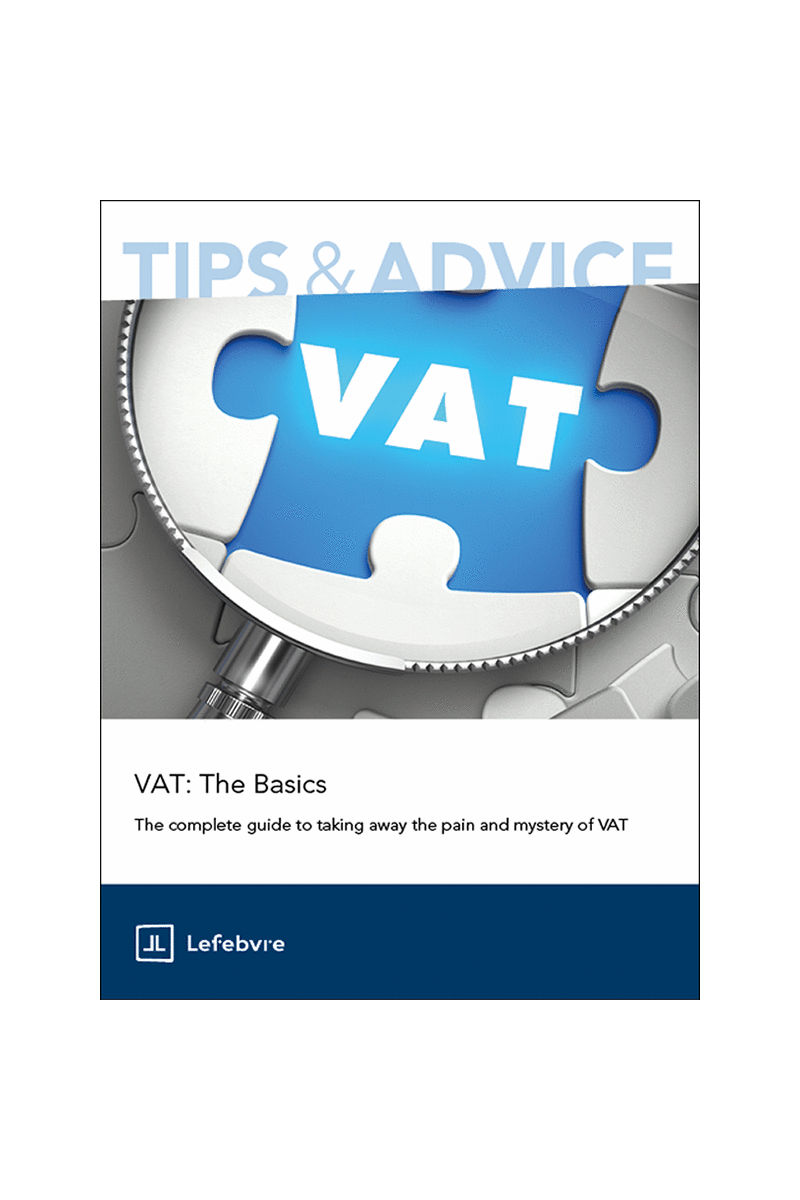VAT: The Basics
The complete guide to taking away the pain and mystery of VAT

A Tips & Advice Special Report about...
In a nutshell
Understanding how VAT works is vital for all business owners. For many businesses VAT is unavoidable as they are formally required to register. Others may want to register voluntarily to recover VAT on costs. Whatever your situation, our back-to-basics guide to all things VAT is sure to simplify the process. It’s a broad and easy-to-understand introduction to the VAT system that will help your business gain confidence in tackling VAT reporting with ease.
In detail
VAT is almost 50 years old, and yet it can still evoke thoughts of complex rules, infamous court cases, and dreaded VAT inspections. However, for most routine trading businesses, the more complex aspects of VAT don’t really come into play. This Special Report gives a grounding in getting started with VAT, covering:
- An introduction to VAT and taxable supplies
- Registration: how, when and why?
- Record keeping requirements and Making Tax Digital
- Output tax: what should I charge?
- Input tax: what can I claim?
- Partial exemption: businesses with more than one activity
- HMRC’s powers and the new VAT penalty system
- VAT schemes that can help small businesses
If you’re new to VAT, are thinking of registering to save money, or if you’re looking to take over reporting yourself to cut costs, this Special Report will give you the confidence to do it correctly and safely.
For who
We've created this Tips & Advice Special Report especially for...
Everyone who wants to:
- Get a good grounding in the basics of the UK VAT system
- Confidently tackle VAT reporting in their business
Advisors who want to:
- Brush up on their VAT knowledge and understand the latest rules
Extras
You'll get the following free extras with this Tips & Advice Special Report...
An online service with ready-to-use documents
- To immediately apply our advice and solutions in practice
- That you can easily adapt to suit your own requirements
| Type of product | |
|---|---|
| Identifier (EAN / ISSN / Action Code) | 9781911744382 |
| Availability | In stock |
| Publisher | Lefebvre UK |
| Publication Date | Jul 4, 2025 |
Table of contents
1. An introduction to VAT and taxable supplies
1.2. Which transactions is VAT applied to?
1.3. What is a taxable person?
1.5. When is a supply made in the UK?
1.7. What counts as a business?
1.8. What are exempt and “outside the scope” transactions?
1.9. What do the terms “output tax” and “input tax” mean?
1.10. What rate is VAT charged at?
2. Registration: how, when and why?
2.1. What is VAT registration?
2.2. When does a business need to register?
2.4. What income counts for the purposes of the £90,000 tests?
2.5. Why would I register voluntarily?
2.6. What VAT planning is possible when registering?
2.7. Can I backdate a registration to maximise recovery?
2.9. When will I need to start charging VAT?
2.10. What if I need to charge VAT before receiving my VAT number?
3. Record keeping requirements and Making Tax Digital
3.1. What requirements do I need to adhere to once registered?
3.2. Is there a required form of VAT invoice?
3.4. When is the VAT return due?
3.5. What if I make a mistake?
3.6. What is Making Tax Digital?
3.7. Do I need to buy new software?
4. Output tax: what should I charge?
4.1. When do I charge output tax?
4.2. How do the basic tax point rules work?
4.3. When does the actual tax point override the basic tax point?
4.4. Can I opt out of the 14-day rule?
4.5. What about extending the period?
4.6. What if the customer pays early?
4.7. Are there any planning opportunities with the tax point rules?
4.8. What amount do I add the VAT to?
4.9. How do I value non-monetary consideration?
4.10. What if there is no consideration?
4.11. Can HMRC impose VAT where there is no commercial supply?
4.13. What if I make occasional gifts to my employees?
4.15. Do these rules apply to all self-supplies?
4.16. I’ve reported all my output tax, but the customer isn’t paying the invoice. What can I do?
4.17. Is there a way to speed up relief?
5. Input tax: what can I claim?
5.2. What counts as a business purpose?
5.3. What if there is a mix of business and non-business expenditure?
5.5. What does “attributable to taxable supplies” mean?
5.6. When is input tax blocked?
5.8. What about fuel for vehicles?
5.9. When is a supply made to the claimant?
5.10. How do I know if VAT has been correctly charged?
6. Businesses with more than one activity: partial exemption
6.1. When is a business “partially exempt”?
6.2. What are the de minimis limits?
6.3. What is the standard method of apportionment?
6.4. What about special methods?
6.5. When do I need to make the annual adjustment?
6.6. What happens if the intended use of an asset changes?
7. HMRC’s powers and the penalty system
7.1. What powers does HMRC have in respect of VAT?
7.2. What are assurance visits?
7.3. What information is HMRC entitled to?
7.4. When will HMRC request security?
7.5. What are distress proceedings?
7.6. When can joint and several liability be applied?
7.7. What do I need to know about VAT assessments?
7.8. How does the VAT penalty system work?
8. VAT schemes that can help small businesses
8.1. What is the flat rate scheme?
8.2. What are the advantages and disadvantages?
8.3. What is the cash accounting scheme?
8.4. When is the CAS likely to be beneficial to me?
8.5. Can I use the CAS and FRS at the same time?
8.6. What is the annual accounting scheme?
8.8. Are there any disadvantages?